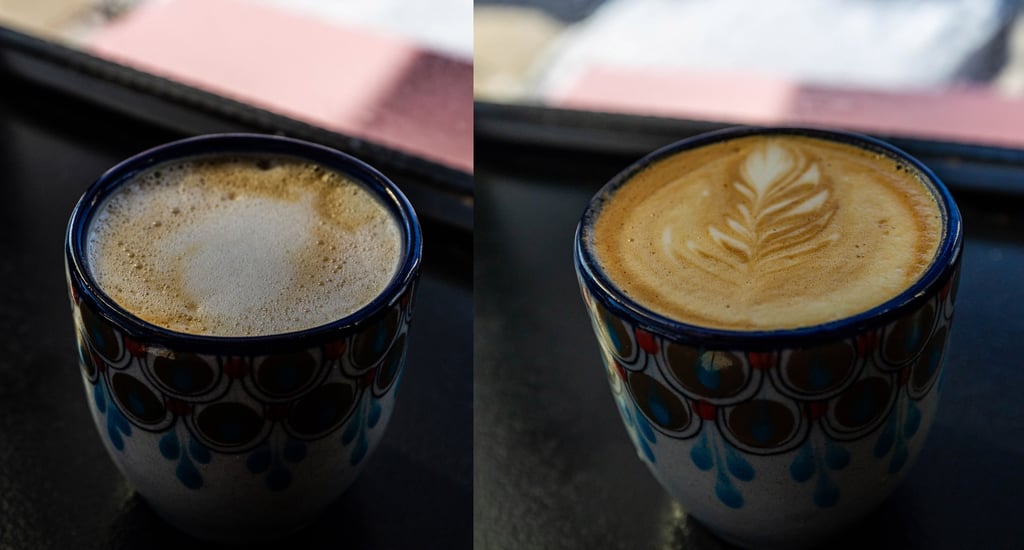Understanding the Differences Between Wet and Dry Cappuccino
Cappuccinos are a staple of coffee culture, but did you know there’s more than one way to enjoy this classic drink? The terms “wet” and “dry” refer to the balance of steamed milk and foam, creating two distinct experiences.


When ordering a cappuccino, two terms stand out: “wet” and “dry.” These descriptors indicate the balance between steamed milk and foam:
Wet Cappuccino: Creamy and smooth, with more steamed milk and less foam. The additional milk softens the espresso’s intensity, resulting in a slightly sweeter flavor.
Dry Cappuccino: Bold and airy, with less steamed milk and a generous amount of foam. This style emphasizes the espresso’s robust bitterness while keeping the drink light.
For an even drier experience, you can order a “bone dry” cappuccino, which is made entirely of espresso and foam, skipping steamed milk altogether. Conversely, if you prefer extra milk, a “super wet” cappuccino is essentially a latte.
The Intricacies of a Wet Cappuccino
A wet cappuccino offers a rich and creamy coffee experience, striking a delicate balance between the boldness of espresso and the smoothness of steamed milk. Unlike its dry counterpart, the wet cappuccino leans toward a latte-like texture, while still retaining the structure and character of a traditional cappuccino. Here’s what makes it unique:
1. Milk-to-Espresso Ratio
In a standard cappuccino, the ratio of espresso, steamed milk, and foam is roughly 1:1:1. However, a wet cappuccino skews this balance by increasing the proportion of steamed milk and reducing the foam. The result is a drink with a silkier, creamier mouthfeel and a slightly sweeter taste, as the steamed milk tempers the espresso’s natural bitterness.
2. Texture of the Milk
The hallmark of a wet cappuccino is its velvety texture. To achieve this, baristas must master the art of steaming milk to create a dense, micro-foamed consistency. The milk should be free of large bubbles and glossy in appearance, creating a luxurious, pourable texture that integrates seamlessly with the espresso.
3. Steaming Technique
Crafting the milk for a wet cappuccino requires careful technique:
The barista stretches the milk (introducing air) for a shorter duration than in a dry cappuccino.
Once stretched, the milk is rolled in the pitcher by angling it slightly and steaming it until it reaches a creamy, cohesive texture.
The foam layer, while thinner than that of a dry cappuccino, should still be present to provide structure and visual appeal.
4. Taste Profile
The added steamed milk in a wet cappuccino brings out the natural sweetness of the milk while mellowing the espresso’s intensity. This balance makes the wet cappuccino an ideal choice for those who enjoy the bold flavor of coffee but prefer a less pronounced bitterness. The espresso still shines through, but it’s softened by the creaminess of the milk.
5. Presentation
A wet cappuccino is typically served in a 6–8 oz cup. The smaller size ensures that the milk-to-espresso ratio remains balanced, preventing the drink from becoming overly milk-forward. Latte art is often a feature of wet cappuccinos, as the milk’s texture is ideal for creating intricate designs.
6. Customization Options
To further refine a wet cappuccino, you can experiment with milk types, such as oat, almond, or whole milk, each of which will bring its own unique flavor and texture. Additionally, flavor syrups like vanilla or caramel can complement the drink’s creaminess without overpowering the espresso.
The Art of the Perfect Wet Cappuccino
Creating a wet cappuccino requires precision, skill, and a keen understanding of the interplay between milk and espresso. From steaming the milk just right to pouring it over the espresso with care, every step plays a crucial role in crafting this creamy, balanced coffee drink. A well-made wet cappuccino is a testament to the barista’s craft and a true delight for coffee enthusiasts seeking the perfect blend of boldness and smoothness.
The Intricacies of a Dry Cappuccino
A dry cappuccino offers a bold, airy coffee experience that emphasizes the espresso’s intensity while incorporating the light texture of milk foam. It’s a drink for those who appreciate the strength of espresso without much dilution and prefer the tactile sensation of frothy foam. Here’s a closer look at what makes a dry cappuccino special:
1. Milk-to-Espresso Ratio
A dry cappuccino shifts the traditional cappuccino ratio (1:1:1 of espresso, steamed milk, and foam) by minimizing the steamed milk and maximizing the foam. The result is a drink that delivers a strong espresso flavor with only a whisper of creaminess from the milk.
2. Foam Texture
The foam is the star of the show in a dry cappuccino. To achieve the desired texture, baristas must skillfully aerate the milk during the steaming process. The goal is to create a thick, dense foam with a light, airy structure. Unlike the silky microfoam used in lattes or wet cappuccinos, the foam for a dry cappuccino has a frothy, cloud-like quality that adds height and volume to the drink.
3. Steaming Technique
Crafting milk foam for a dry cappuccino requires precision and technique:
The barista stretches the milk by introducing air for a longer duration than with a wet cappuccino.
The milk is steamed to a slightly higher temperature to create a lighter, frothier texture.
Careful attention is given to avoiding large bubbles, ensuring the foam remains consistent and smooth.
4. Taste Profile
The dry cappuccino showcases the espresso’s bold flavor. With less steamed milk to dilute the coffee, the drink retains its robust, slightly bitter profile. The foam provides a subtle creaminess without overpowering the espresso, making it ideal for those who want to savor the distinct characteristics of the coffee beans.
5. Presentation
A dry cappuccino is typically served in a 6 oz cup to maintain a proper balance between foam and espresso. The foam forms a thick layer on top of the espresso, often creating a visually appealing contrast. Latte art is less common in dry cappuccinos because the foam’s texture doesn’t lend itself to intricate designs, but a simple swirl or dome of foam can still enhance the presentation.
6. Insulation and Temperature
One advantage of a dry cappuccino is its natural insulation. The thick layer of foam acts as a barrier, helping the drink retain heat for a longer period. This makes it a great choice for slow sippers who want their coffee to stay warm as they enjoy it.
7. Customization Options
Like any coffee beverage, a dry cappuccino can be personalized. Experimenting with different milk types—such as almond, oat, or whole milk—can alter the flavor and foam consistency. Adding a dusting of cocoa powder, cinnamon, or nutmeg on top of the foam can elevate the drink’s aroma and taste.
The Art of the Perfect Dry Cappuccino
Creating a dry cappuccino requires skill, timing, and an understanding of milk’s behavior. The foam must be expertly crafted to achieve the right texture and balance. A well-made dry cappuccino is not only a treat for espresso lovers but also a testament to the barista’s mastery of their craft. It’s a drink that lets the coffee shine, with just a whisper of milk to round out the flavor.
Which do you Prefer?
The choice between wet and dry cappuccinos ultimately comes down to personal preference. Whether you’re drawn to the rich, silky profile of a wet cappuccino or the bold, espresso-forward experience of a dry cappuccino, both variations showcase the artistry and precision of a skilled barista. Understanding these nuances allows you to appreciate the depth and complexity behind this beloved coffee drink—and helps ensure your next cappuccino order is crafted just the way you like it.


